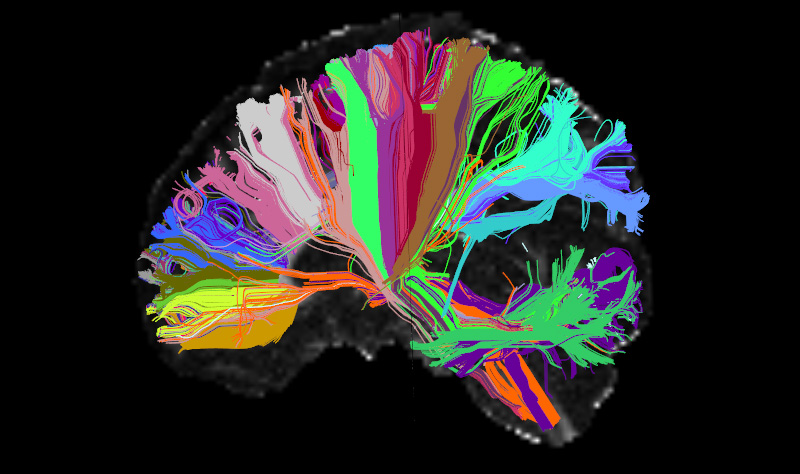
Credit: Anastasia Yendiki, Ph.D., Viviana Siless, Ph.D., MGH/Harvard, Boston Adolescent Neuroimaging of Depression and Anxiety (BANDA)
Cross-posted from The BRAIN Blog
NIH’s BRAIN Initiative is marking a milestone—10 years of advancing neuroscience and neurotechnology research by funding innovative projects. Dr. Bianchi shares her voice and perspective on the impact BRAIN has made on NICHD’s mission.
NICHD leads research and training to understand human development, improve reproductive health, enhance the lives of children and adolescents, and optimize abilities for all. This includes supporting basic, translational, and clinical research in the biomedical and behavioral neurosciences, particularly as they affect development and rehabilitation. Research within NICHD’s National Center for Medical Rehabilitation Research seeks to enhance the health, productivity, independence, and quality of life of people with physical disabilities—including those from chronically injured nervous and musculoskeletal systems.
BRAIN Initiative research is helping us to achieve our goals through a better understanding of the human brain. Our staff work collaboratively with the other nine NIH institutes and centers participating in the BRAIN Initiative. We develop funding opportunities, recommend projects to be funded, and organize workshops and meetings. BRAIN Initiative funding has also advanced research within our intramural program. For example, NICHD’s Peter Basser, Ph.D., and his team have been involved with investigating the “connectome”—the complete set of connections within the brain.
How has the BRAIN Initiative advanced or shaped your mission?
Being part of BRAIN aligns with NICHD’s Strategic Plan, including helping us work toward some of our aspirational goals, such as developing tools to identify biomarkers of atypical neurodevelopment that can predict neurodegenerative disorders later in life. BRAIN’s support is also critical for training the next generation of scientists to harness the techniques necessary for future investigation, with a particular focus on involving early-career scientists.
Which BRAIN-funded scientific advancements have been most exciting for NICHD?
BRAIN has enabled critical advances in rehabilitation therapies, including for stroke—a leading cause of persistent physical disabilities that affect daily living. In an early-stage clinical trial, 9 out of 12 participants with impaired upper limb function after stroke experienced improved hand and arm movement following cerebellar deep brain stimulation (DBS) plus physical therapy. These improvements persisted even after DBS, in which a surgically implanted neurostimulator and electrodes convey electrical impulses to specific brain areas, was turned off. These highly encouraging results help set the stage for larger studies and toward helping individuals regain function and quality of life after stroke.
Other BRAIN-supported work has illuminated patterns of brain activity associated with chronic pain. Researchers recorded pain-related data from inside the brains of three people with chronic pain after stroke and one with phantom limb pain after amputation. Identifying biomarkers of chronic pain is the first step toward the development of new, effective, and non-addictive pain treatments. This research also informs ongoing studies supported by BRAIN and the NIH HEAL Initiative, in which NICHD plays a major role, toward using DBS as a personalized approach to treat chronic pain.
BRAIN has also expanded what we know about neurodevelopment. Using precise single-cell analysis techniques, researchers in the BRAIN Initiative Cell Census Network (BICCN) have uncovered developmental changes at the levels of cells, molecules, and genes . Recently, BICCN published a comprehensive single-cell atlas of the entire mouse brain with work continuing on an atlas of the developing mouse brain. The BRAIN Initiative Cell Atlas Network (BICAN), one of BRAIN’s Transformative Projects, is expanding this foundational work, toward generating atlases of the developing brains of humans and non-human primates.
A team-building grant from BRAIN helped NICHD intramural researchers form a transdisciplinary group of experts to use noninvasive magnetic resonance imaging (MRI) methods to measure the “latency connectome”—the time it takes for nervous impulses to travel from one part of the brain to another. NICHD scientists also helped develop the Connectome 2.0 MRI scanner, which can detect fine-scale structures in the human brain that are currently invisible using clinical MRI scanners. These scientists also are part of a team working to develop a Next Generation 7T MRI for high-resolution imaging of cortical layers and areas.
Why do you think it’s important for NICHD to participate in the NIH BRAIN Initiative?
From enhancing knowledge of early development to improving medical rehabilitation, the BRAIN Initiative helps support NICHD’s vision: “Healthy pregnancies. Healthy children. Healthy and optimal lives.” In addition to BICAN projects, other BRAIN research continues to illuminate neurodevelopmental processes. Projects include clarifying the role of an enzyme linked to intellectual disability and understanding mechanisms that drive neuron-microglia interactions during fetal brain development. Other work is examining ethical issues related to use of DBS to treat children with dystonia, epilepsy, Tourette syndrome, and other neuropsychiatric conditions—as well as developing decision-support tools for families and health care providers. Another BRAIN Initiative project is evaluating a potential treatment for Lennox-Gastaut syndrome, a severe form of childhood-onset epilepsy. These are just a few examples of BRAIN Initiative projects that are advancing the NICHD mission in foundational ways. I look forward to future insights resulting from this unique research investment.
 BACK TO TOP
BACK TO TOP